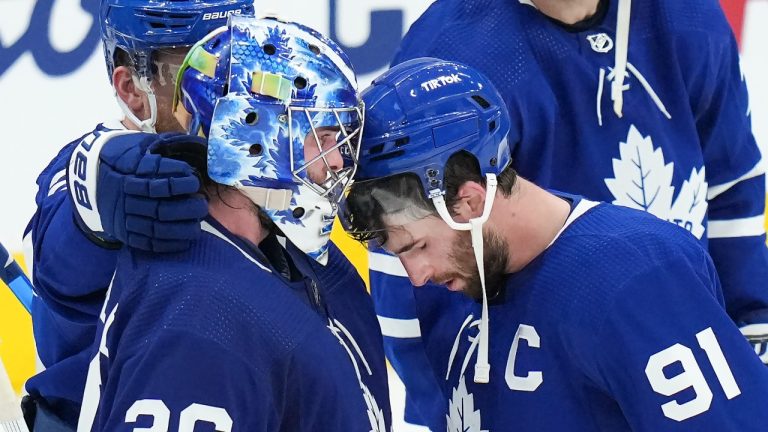With the Toronto Maple Leafs season behind us, it’s time to hand out report cards. I’m not a huge fan of letter grades (do they even use those anymore?), so we’re going with written reports like it’s kindergarten. A few sentences on each guy, how their season was and what it means for the Leafs going forward.
Please keep in mind, this is an assessment of the 89 games the Leafs played this season, of which they won damn near 70 per cent of the time. Looking at the big picture, a lot of players had to have really great seasons for the playoff disappointment to resonate with fans the way it did. People believed, and they should have.
FORWARDS
I said I’m not doing letter grades, but let’s keep Matthews quick with an A+. He set the franchise record for goals in a season, finished sixth in league scoring despite playing just 73 games, and is likely to win the Hart Trophy as the league’s most valuable player. Decent year, I’d say. Special year for a special player.
Mitch Marner
Two players in the NHL’s top-10 in scoring played fewer than 80 games: Matthews and Marner, who put up 97 points in 72 games. Elite game-breakers are the hardest thing to come by in the sport, and Marner was that for the Leafs. He’s a part of their solution, not their problem.
Bunting made less than $1 million against the Leafs cap, and contributed over 20 goals and 60 points and dressed in 79 games, finishing third in the NHL in penalties drawn with 45(!), one spot behind Connor McDavid. He played over 15:30 per game and did everything asked of him. That they have him under that same contract for another season is ludicrous value.
Alex Kerfoot
There are 32 teams in the league. That means if you took the top two point-getters on every team, you’d have 64 players. In even-strength points this season, Kerfoot finished inside the top 60, tallying 47 even-strength points. For context, some players around 50 even-strength points: Mike Zibanejad (48), William Nylander (49), Andrei Svechnikov (49), John Tavares (50), Brady Tkachuk (50), Sebastian Aho (50), Brad Marchand (51) and Mark Scheifele (51). He was dynamite on the penalty kill, and he can play just about every forward spot except 1C and fit fine. By any objective measure he had a good year, and provided value on his contract. Whether or not they want to allocate his money differently in the future will purely be about a preference in style, not his ability.
John Tavares
Tavares was just outside the top 40 in league scoring, operating at about a point-per-game pace, picking up 76 in 79 games. It’s reasonable to suggest that his year in a vacuum was a good one, but it doesn’t exist in a vacuum: He makes $11 million a year, is the captain of the Toronto Maple Leafs and there’s angst that comes from “What comes next?” Even though his points per game and shots per game held or even ticked up slightly from years past, his per-game goal output has declined over his four years in Toronto (.57, .41, .34, .34), and this year he played with excellent players on a good team and on the first power play. His lines didn’t control play against good opposition in big games. It all amounts to a tough year to grade, but because the past itself grades out OK, the concern lies with the future.
William Nylander
The World’s Most Polarizing Hockey Player had an absolutely stellar season … when you zoom out and the precise moments when you wish he’d have done something differently blur just enough. Stellar! An elite 80 points in 81 games, including 34 snipes, which was just outside the top 30 in the first category and inside it in the second. We have an audio drop on “Real Kyper and Bourne” of Auston Matthews saying, “When he’s going he’s going, right?” and nothing sums the man up better. I’ll end it the way I ended Kerfoot’s blurb: he had an objectively good year. If he’s not going to be a part of the Leafs in the future, it will be about a preference in playing style, not ability.
Ilya Mikheyev
As a Leafs observer, I will miss Ilya Mikheyev, I really will. He had a tremendous year on a cheap deal. He was a fun player to watch and could create chaos in sleepy moments with his speed, particularly on the PK. He was great depth for the Leafs, and regularly provided them with quality minutes. But with a “Did I black out?” shooting percentage of 14.3 per cent – after years of 6.5 per cent and 8.2 per cent – for a goal total of 21 in just 53 games, and his lack of previous career earnings, and his UFA status, and an agent who this past season tweeted a Jerry McGuire “Show me the money” GIF and yeah … he's gone. Good year, though.
David Kampf
On a team with several pleasant surprises, Kampf was maybe the pleasant ... est. A D-zone start machine who was elite on faceoffs, and who played tough competition and still carried the run of play, finishing above 50 per cent in all possession metrics. He flourished in the playoffs in the toughest environments in the biggest moments. He played in all 89 Leafs games, scoring 13 goals after a season in which he scored just once. He was a part of the depth that made the Leafs a home-ice advantage team in a tough division, he’s cheap and he’s under contract for another year.
Ondrej Kase
Kase was on the pleasant side of expectations, in that he managed to play 50 games and was a valuable contributor when he was in. He scored 14 goals (a 23-goal pace), which was tied for his second-best goals-per-60 pace of his career. He killed penalties and went to the dirty areas and played the only way he knows how. The problem is, he may have to figure out another way, or he’s going to put his health after his career at risk. He suffered more injuries, and while he did what he could to come back and be available when the team needed him – like the absolute warrior he is – he wasn’t the same player at year’s end that he was in the middle of the season. I have a great respect for the player, and think he’s a damn good one. But quite honestly I worry about the guy.
Pierre Engvall
Engvall somehow managed to be the most frustrating player on a roster with William Nylander. After starting out the season in the coach’s dog house, he morphed into a super-valuable third-line contributor and an outright threat on the PK. He’s one of the league’s elite skaters, he’s huge, he can rip the puck and somehow … somehow he can sleep through weeks of hockey at a time. It was a good season for Engvall, who scored 14 goals and earned a meaningful place on the roster. Good Engvall, you could argue, may have even deserved more opportunity. But the team seemed to have no control over when that version showed up, and it didn’t in the playoffs – not at all – which you can argue was one of the small margins where Tampa found victory over Toronto – on the third lines. The end of his season should keep his next contract down, and he’s still a valuable depth piece, provided the dollars stay down.
Jason Spezza
He makes the league minimum, so let’s start there for expectations. For that cost, a dozen goals and 25 points and elite faceoff work is undeniably value. You worry about what another full year means to someone nearing 40 years old, and that’s a debate the Leafs can have internally when considering bringing him back. But as for the year that was, it was a success.
Wayne Simmonds
Simmonds was something the Leafs didn’t really have, which was good to have: a physical threat. I think he made players feel safer, as he fought and won fights at times. But the large portion of the nights he wasn’t much of a contributor. You’d like your fourth line to provide energy, or to kill penalties, or have some more relevant niche. Waiting for physical altercations to escalate to be relevant didn’t feel like the best use of a lineup spot most nights.
Kyle Clifford
Clifford felt like Simmonds if you tweaked the attribute values down on “fighting ability” and up on “hitting ability.” I thought Clifford offered better energy in his minutes than Simmonds most nights, while his “best nights” weren’t as good as Simmonds'. Regardless, I can’t help but feel the Leafs need to retool with a fourth line that can skate and hit and kill penalties some. They’ve had no identity in this spot for years.
Colin Blackwell
I asked for energy, and Blackwell brought it, no denying that. Unfortunately, at his size, a guy who skates like crazy and runs into people isn’t the most intimidating or effective fourth-liner. That said, if he were on the third line and PK and not a straight-up “fourth-liner,” I think he could help. Could he be effective in Mikheyev’s minutes next season? He’s scored at a 20-goal pace in the past and can kill penalties.
DEFENCEMEN
Rielly earned his upcoming pay raise, being dynamic and effective and a big part of the Leafs' success. Are there complaints? Sure, I’d like fewer defensive oopsies, and maybe a little quicker puck movement on the power play. But he made a piddly five mill this past season for double-digit goals and nearly 70 points; that right there is a win, win, win, win for the team.
Ilya Lyubushkin
I’m Team Lyubushkin all the way. He provided the Leafs something their D-corps desperately needed, a body who’d at least bang into an opposing body and force them to rush plays and at least hesitate occasionally. He battled for ice at the net front and could hang with big, mean forwards in the corners. There’s a reason he’s not being talked about as Chris Pronger 2.0 or something – he made defensive coverage gaffes and wasn’t overly confident with the puck, either. But he was coming from a market that played in front of nobody in games that had no stakes in Arizona. I think he should still be cheap, and that with a little more time and patience he could be a really good D-man in the year ahead.
Jake Muzzin
Muzzin is the D-corps version of John Tavares, where you don’t hate his past year at all, you just have concerns about what comes next. He seemed to need help carrying a pair the way JT needed help carrying a line, whereas both were able to pick up lesser players in their primes and elevate them. At his cap hit, he can probably top out at “worth the money.” The days of getting value from his deal are likely done. But like Lyubushkin, he plays a grittier version of hockey, which the Leafs need more of, not less, which would make him hard to subtract. … That, and the no-trade clause.
T.J. Brodie
Brodie is the fixer. Morgan Rielly looks his best with Brodie, so does Muzzin, so does Justin Holl, so does … everyone. At some point, you recognize the huge value of a guy who elevates his teammates. No, he’s not physical, but he’s smooth and smart and useful. He’s not going to get better, though, so you just hope the decline years don’t come knocking just yet.
Mark Giordano
I don’t think Gio is the D-corps version of Jason Spezza, not yet. He was logging over 20 minutes per night for the Leafs, and was a calming influence on whoever he played with. His brain allows him to stay effective while killing penalties, protecting leads and moving the puck to the right places on offence when he gets his touches. Another year of age and decline for older players, well, those tend to accelerate in severity pretty quick around his age. If he’s cheap, you want him, if he's up over $2 million per season, he’s not an option for the Leafs.
Rasmus Sandin
There’s suddenly a lot of pressure on Sandin, who the Leafs really liked right away, and had high hopes for. I think they were a little let down he didn’t take a bigger step than the one he took. That said, I’m still super high on his potential, and can see him being a valuable second-pair guy who sees power-play time. There’s a steadiness to his game that I admire, if he can figure out how to better defend at his size – a challenge in the NHL – he’ll take a huge step for the team.
Timothy Liljegren
Liljegren had a wildly successful year, a guy who – for a while there – felt like he just may never make the jump to the NHL. Not only did he successfully do that, he found his way into a pretty good D-corps, and even a couple playoff games. He added a physical element to his play and found confidence in his puck-moving on the offensive side. He’s still prone to defensive lapses and plays way up the rink in the offensive zone, which worries me at times. But that style earned him great possession numbers, and a likely roster spot for next year. If it’s in the top six or even top four, that's up to Liljegren.
GOALTENDERS
What an absolute roller coaster. If I told you he was a .914 save percentage in 50 games, you’d be like “What a stud!” But he was actually below average in some “expected saves” stats and he had a run of months as one of the bottom goalies in the league. He’s probably an NHL starter, and when you don’t have another option, he definitely is, but how much are those stats going to cost for a guy who's a good age and been an important guy on a good team for a couple years? If you’re the Leafs, you’re hoping not toooooo much?
Petr Mrazek
If I said, “Draw up the worst-case scenario year for this signing,” could you do worse? OK, probably, but you get the point. It’s not a matter of if they unload Mrazek, it’s how. Buyout? Trade and retain? Trade and attach an asset? It was that bad.
Erik Källgren
Erik Källgren’s greatest accomplishment is becoming someone whose name fans in Toronto had to learn to pronounce. Goalies are impossible to predict, so I’ll just say he was a calm, pleasant surprise in his Leafs appearances this past season. I don’t think he’s the answer the Leafs need as a backup to Campbell (if he returns), but given the salary cap, they may be hoping one of Källgren or Joseph Woll has one hell of a summer.











COMMENTS
When submitting content, please abide by our submission guidelines, and avoid posting profanity, personal attacks or harassment. Should you violate our submissions guidelines, we reserve the right to remove your comments and block your account. Sportsnet reserves the right to close a story’s comment section at any time.